Tuberculosis: A Detailed Analysis of a Communicable Disease
VerifiedAdded on 2023/01/23
|8
|2254
|24
Report
AI Summary
This report provides a comprehensive analysis of tuberculosis (TB) as a communicable disease. It begins by defining communicable diseases and the chain of infection, focusing specifically on TB caused by Mycobacterium tuberculosis. The report details the transmission process, including how the bacteria spreads through airborne particles and the role of the host. It explores the different sites of infection, symptoms, and diagnostic methods such as sputum collection and chest X-rays. The treatment section covers both latent TB infection and active TB disease, including first-line and second-line drugs, and discusses potential complications and drug resistance. The report also delves into epidemiological aspects, including incidence, prevalence, and mortality rates, while also discussing the health determinants and the role of public health nursing in TB prevention and control, including contact tracing and facilitating diagnostic testing.
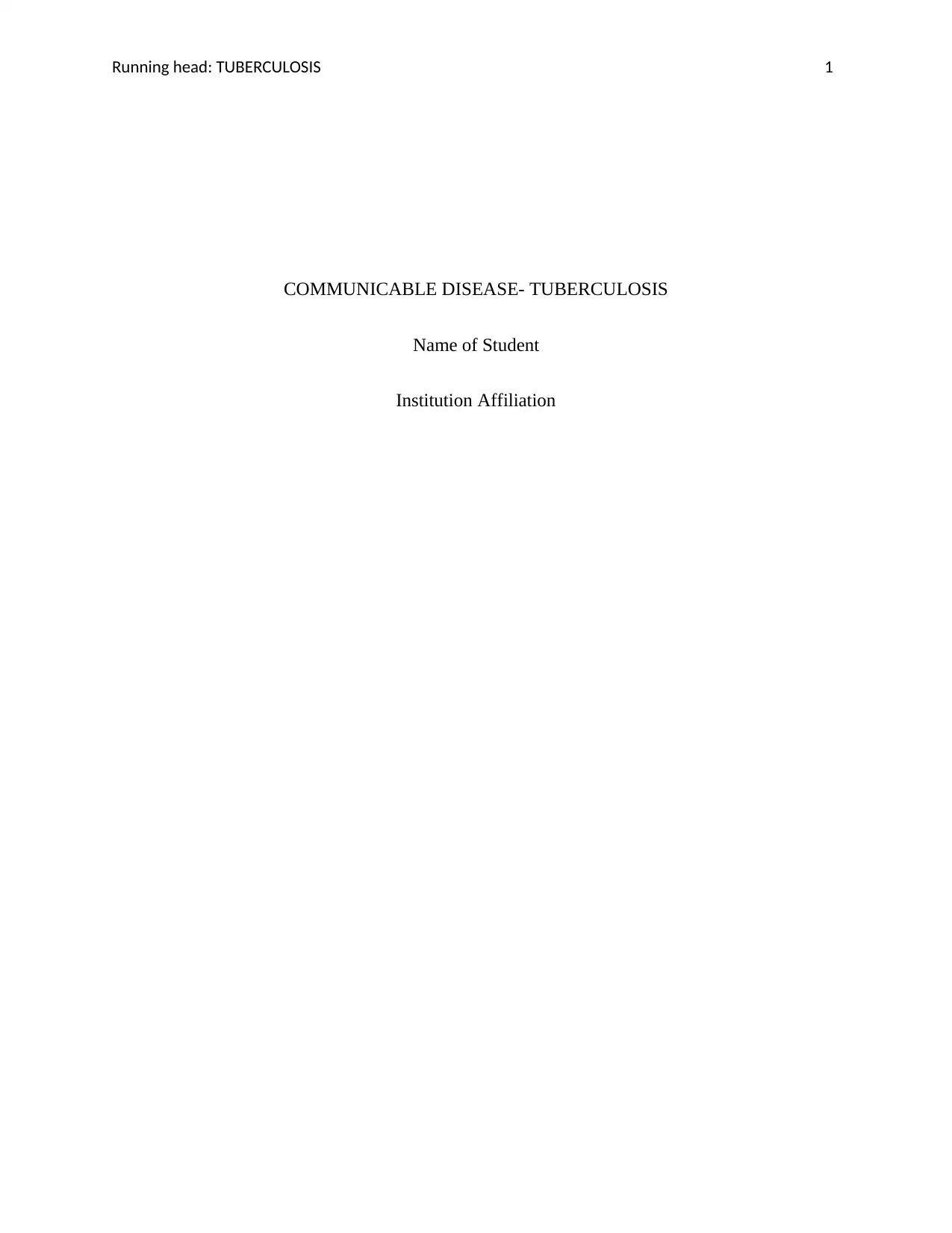
Running head: TUBERCULOSIS 1
COMMUNICABLE DISEASE- TUBERCULOSIS
Name of Student
Institution Affiliation
COMMUNICABLE DISEASE- TUBERCULOSIS
Name of Student
Institution Affiliation
Paraphrase This Document
Need a fresh take? Get an instant paraphrase of this document with our AI Paraphraser
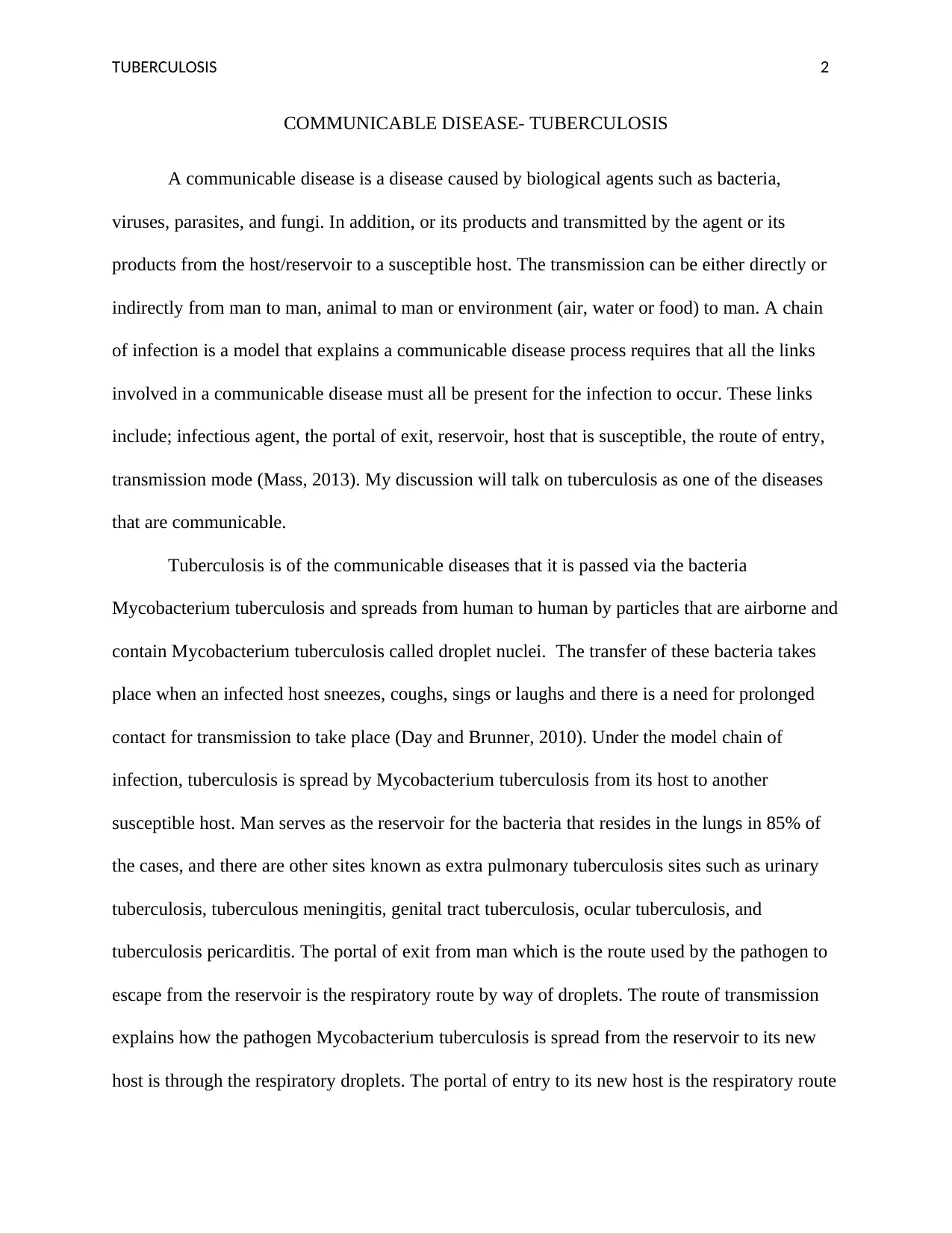
TUBERCULOSIS 2
COMMUNICABLE DISEASE- TUBERCULOSIS
A communicable disease is a disease caused by biological agents such as bacteria,
viruses, parasites, and fungi. In addition, or its products and transmitted by the agent or its
products from the host/reservoir to a susceptible host. The transmission can be either directly or
indirectly from man to man, animal to man or environment (air, water or food) to man. A chain
of infection is a model that explains a communicable disease process requires that all the links
involved in a communicable disease must all be present for the infection to occur. These links
include; infectious agent, the portal of exit, reservoir, host that is susceptible, the route of entry,
transmission mode (Mass, 2013). My discussion will talk on tuberculosis as one of the diseases
that are communicable.
Tuberculosis is of the communicable diseases that it is passed via the bacteria
Mycobacterium tuberculosis and spreads from human to human by particles that are airborne and
contain Mycobacterium tuberculosis called droplet nuclei. The transfer of these bacteria takes
place when an infected host sneezes, coughs, sings or laughs and there is a need for prolonged
contact for transmission to take place (Day and Brunner, 2010). Under the model chain of
infection, tuberculosis is spread by Mycobacterium tuberculosis from its host to another
susceptible host. Man serves as the reservoir for the bacteria that resides in the lungs in 85% of
the cases, and there are other sites known as extra pulmonary tuberculosis sites such as urinary
tuberculosis, tuberculous meningitis, genital tract tuberculosis, ocular tuberculosis, and
tuberculosis pericarditis. The portal of exit from man which is the route used by the pathogen to
escape from the reservoir is the respiratory route by way of droplets. The route of transmission
explains how the pathogen Mycobacterium tuberculosis is spread from the reservoir to its new
host is through the respiratory droplets. The portal of entry to its new host is the respiratory route
COMMUNICABLE DISEASE- TUBERCULOSIS
A communicable disease is a disease caused by biological agents such as bacteria,
viruses, parasites, and fungi. In addition, or its products and transmitted by the agent or its
products from the host/reservoir to a susceptible host. The transmission can be either directly or
indirectly from man to man, animal to man or environment (air, water or food) to man. A chain
of infection is a model that explains a communicable disease process requires that all the links
involved in a communicable disease must all be present for the infection to occur. These links
include; infectious agent, the portal of exit, reservoir, host that is susceptible, the route of entry,
transmission mode (Mass, 2013). My discussion will talk on tuberculosis as one of the diseases
that are communicable.
Tuberculosis is of the communicable diseases that it is passed via the bacteria
Mycobacterium tuberculosis and spreads from human to human by particles that are airborne and
contain Mycobacterium tuberculosis called droplet nuclei. The transfer of these bacteria takes
place when an infected host sneezes, coughs, sings or laughs and there is a need for prolonged
contact for transmission to take place (Day and Brunner, 2010). Under the model chain of
infection, tuberculosis is spread by Mycobacterium tuberculosis from its host to another
susceptible host. Man serves as the reservoir for the bacteria that resides in the lungs in 85% of
the cases, and there are other sites known as extra pulmonary tuberculosis sites such as urinary
tuberculosis, tuberculous meningitis, genital tract tuberculosis, ocular tuberculosis, and
tuberculosis pericarditis. The portal of exit from man which is the route used by the pathogen to
escape from the reservoir is the respiratory route by way of droplets. The route of transmission
explains how the pathogen Mycobacterium tuberculosis is spread from the reservoir to its new
host is through the respiratory droplets. The portal of entry to its new host is the respiratory route
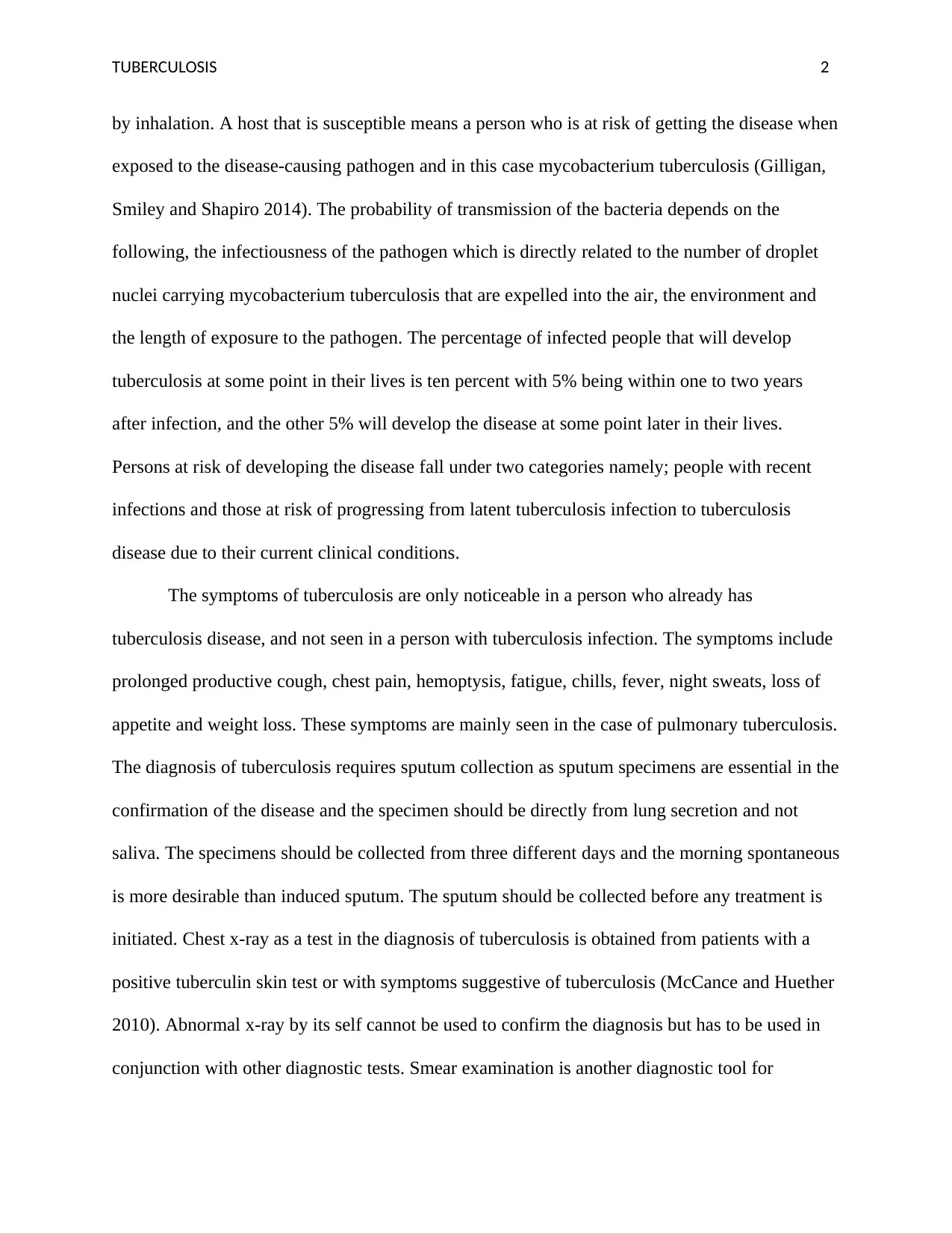
TUBERCULOSIS 2
by inhalation. A host that is susceptible means a person who is at risk of getting the disease when
exposed to the disease-causing pathogen and in this case mycobacterium tuberculosis (Gilligan,
Smiley and Shapiro 2014). The probability of transmission of the bacteria depends on the
following, the infectiousness of the pathogen which is directly related to the number of droplet
nuclei carrying mycobacterium tuberculosis that are expelled into the air, the environment and
the length of exposure to the pathogen. The percentage of infected people that will develop
tuberculosis at some point in their lives is ten percent with 5% being within one to two years
after infection, and the other 5% will develop the disease at some point later in their lives.
Persons at risk of developing the disease fall under two categories namely; people with recent
infections and those at risk of progressing from latent tuberculosis infection to tuberculosis
disease due to their current clinical conditions.
The symptoms of tuberculosis are only noticeable in a person who already has
tuberculosis disease, and not seen in a person with tuberculosis infection. The symptoms include
prolonged productive cough, chest pain, hemoptysis, fatigue, chills, fever, night sweats, loss of
appetite and weight loss. These symptoms are mainly seen in the case of pulmonary tuberculosis.
The diagnosis of tuberculosis requires sputum collection as sputum specimens are essential in the
confirmation of the disease and the specimen should be directly from lung secretion and not
saliva. The specimens should be collected from three different days and the morning spontaneous
is more desirable than induced sputum. The sputum should be collected before any treatment is
initiated. Chest x-ray as a test in the diagnosis of tuberculosis is obtained from patients with a
positive tuberculin skin test or with symptoms suggestive of tuberculosis (McCance and Huether
2010). Abnormal x-ray by its self cannot be used to confirm the diagnosis but has to be used in
conjunction with other diagnostic tests. Smear examination is another diagnostic tool for
by inhalation. A host that is susceptible means a person who is at risk of getting the disease when
exposed to the disease-causing pathogen and in this case mycobacterium tuberculosis (Gilligan,
Smiley and Shapiro 2014). The probability of transmission of the bacteria depends on the
following, the infectiousness of the pathogen which is directly related to the number of droplet
nuclei carrying mycobacterium tuberculosis that are expelled into the air, the environment and
the length of exposure to the pathogen. The percentage of infected people that will develop
tuberculosis at some point in their lives is ten percent with 5% being within one to two years
after infection, and the other 5% will develop the disease at some point later in their lives.
Persons at risk of developing the disease fall under two categories namely; people with recent
infections and those at risk of progressing from latent tuberculosis infection to tuberculosis
disease due to their current clinical conditions.
The symptoms of tuberculosis are only noticeable in a person who already has
tuberculosis disease, and not seen in a person with tuberculosis infection. The symptoms include
prolonged productive cough, chest pain, hemoptysis, fatigue, chills, fever, night sweats, loss of
appetite and weight loss. These symptoms are mainly seen in the case of pulmonary tuberculosis.
The diagnosis of tuberculosis requires sputum collection as sputum specimens are essential in the
confirmation of the disease and the specimen should be directly from lung secretion and not
saliva. The specimens should be collected from three different days and the morning spontaneous
is more desirable than induced sputum. The sputum should be collected before any treatment is
initiated. Chest x-ray as a test in the diagnosis of tuberculosis is obtained from patients with a
positive tuberculin skin test or with symptoms suggestive of tuberculosis (McCance and Huether
2010). Abnormal x-ray by its self cannot be used to confirm the diagnosis but has to be used in
conjunction with other diagnostic tests. Smear examination is another diagnostic tool for
⊘ This is a preview!⊘
Do you want full access?
Subscribe today to unlock all pages.

Trusted by 1+ million students worldwide
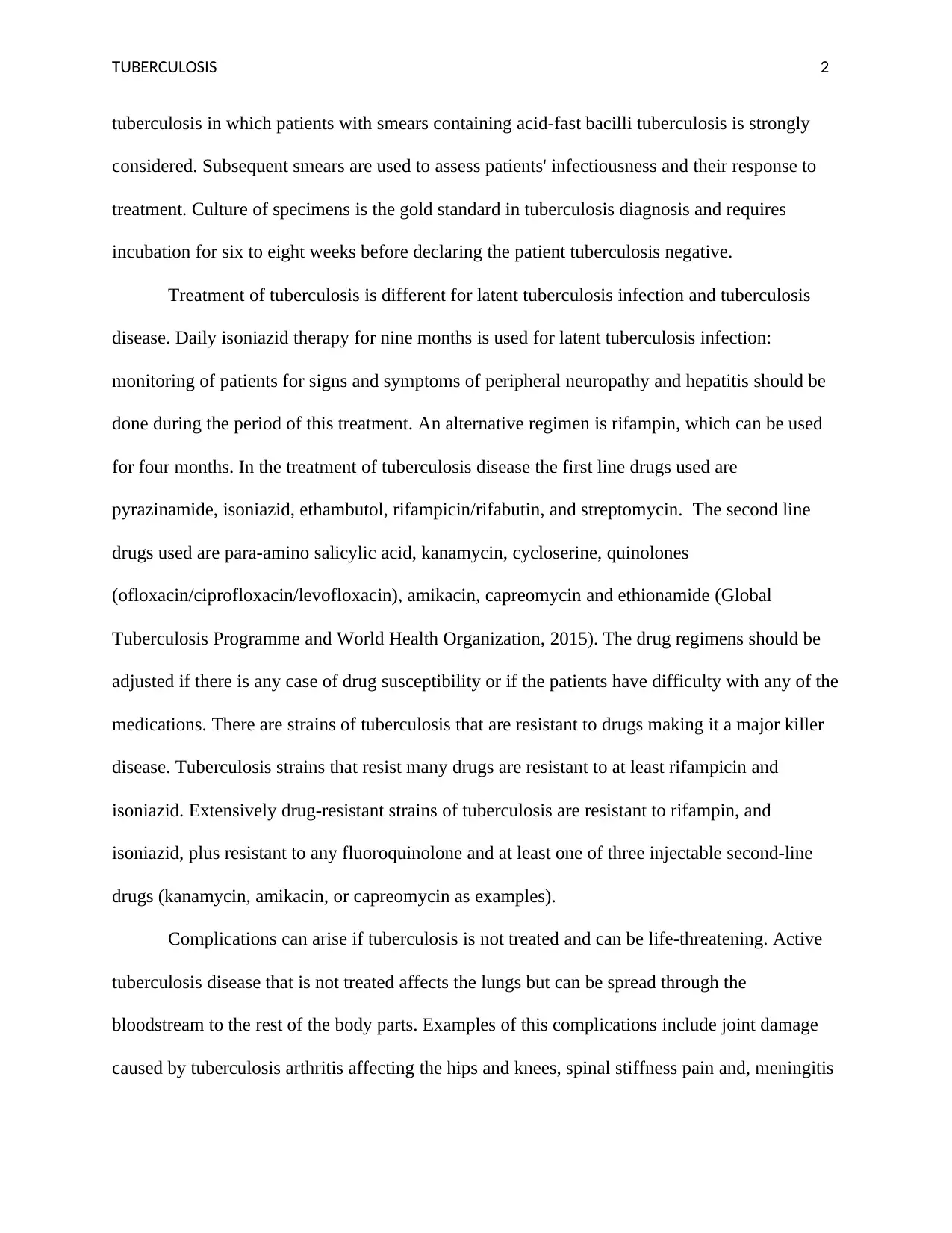
TUBERCULOSIS 2
tuberculosis in which patients with smears containing acid-fast bacilli tuberculosis is strongly
considered. Subsequent smears are used to assess patients' infectiousness and their response to
treatment. Culture of specimens is the gold standard in tuberculosis diagnosis and requires
incubation for six to eight weeks before declaring the patient tuberculosis negative.
Treatment of tuberculosis is different for latent tuberculosis infection and tuberculosis
disease. Daily isoniazid therapy for nine months is used for latent tuberculosis infection:
monitoring of patients for signs and symptoms of peripheral neuropathy and hepatitis should be
done during the period of this treatment. An alternative regimen is rifampin, which can be used
for four months. In the treatment of tuberculosis disease the first line drugs used are
pyrazinamide, isoniazid, ethambutol, rifampicin/rifabutin, and streptomycin. The second line
drugs used are para-amino salicylic acid, kanamycin, cycloserine, quinolones
(ofloxacin/ciprofloxacin/levofloxacin), amikacin, capreomycin and ethionamide (Global
Tuberculosis Programme and World Health Organization, 2015). The drug regimens should be
adjusted if there is any case of drug susceptibility or if the patients have difficulty with any of the
medications. There are strains of tuberculosis that are resistant to drugs making it a major killer
disease. Tuberculosis strains that resist many drugs are resistant to at least rifampicin and
isoniazid. Extensively drug-resistant strains of tuberculosis are resistant to rifampin, and
isoniazid, plus resistant to any fluoroquinolone and at least one of three injectable second-line
drugs (kanamycin, amikacin, or capreomycin as examples).
Complications can arise if tuberculosis is not treated and can be life-threatening. Active
tuberculosis disease that is not treated affects the lungs but can be spread through the
bloodstream to the rest of the body parts. Examples of this complications include joint damage
caused by tuberculosis arthritis affecting the hips and knees, spinal stiffness pain and, meningitis
tuberculosis in which patients with smears containing acid-fast bacilli tuberculosis is strongly
considered. Subsequent smears are used to assess patients' infectiousness and their response to
treatment. Culture of specimens is the gold standard in tuberculosis diagnosis and requires
incubation for six to eight weeks before declaring the patient tuberculosis negative.
Treatment of tuberculosis is different for latent tuberculosis infection and tuberculosis
disease. Daily isoniazid therapy for nine months is used for latent tuberculosis infection:
monitoring of patients for signs and symptoms of peripheral neuropathy and hepatitis should be
done during the period of this treatment. An alternative regimen is rifampin, which can be used
for four months. In the treatment of tuberculosis disease the first line drugs used are
pyrazinamide, isoniazid, ethambutol, rifampicin/rifabutin, and streptomycin. The second line
drugs used are para-amino salicylic acid, kanamycin, cycloserine, quinolones
(ofloxacin/ciprofloxacin/levofloxacin), amikacin, capreomycin and ethionamide (Global
Tuberculosis Programme and World Health Organization, 2015). The drug regimens should be
adjusted if there is any case of drug susceptibility or if the patients have difficulty with any of the
medications. There are strains of tuberculosis that are resistant to drugs making it a major killer
disease. Tuberculosis strains that resist many drugs are resistant to at least rifampicin and
isoniazid. Extensively drug-resistant strains of tuberculosis are resistant to rifampin, and
isoniazid, plus resistant to any fluoroquinolone and at least one of three injectable second-line
drugs (kanamycin, amikacin, or capreomycin as examples).
Complications can arise if tuberculosis is not treated and can be life-threatening. Active
tuberculosis disease that is not treated affects the lungs but can be spread through the
bloodstream to the rest of the body parts. Examples of this complications include joint damage
caused by tuberculosis arthritis affecting the hips and knees, spinal stiffness pain and, meningitis
Paraphrase This Document
Need a fresh take? Get an instant paraphrase of this document with our AI Paraphraser
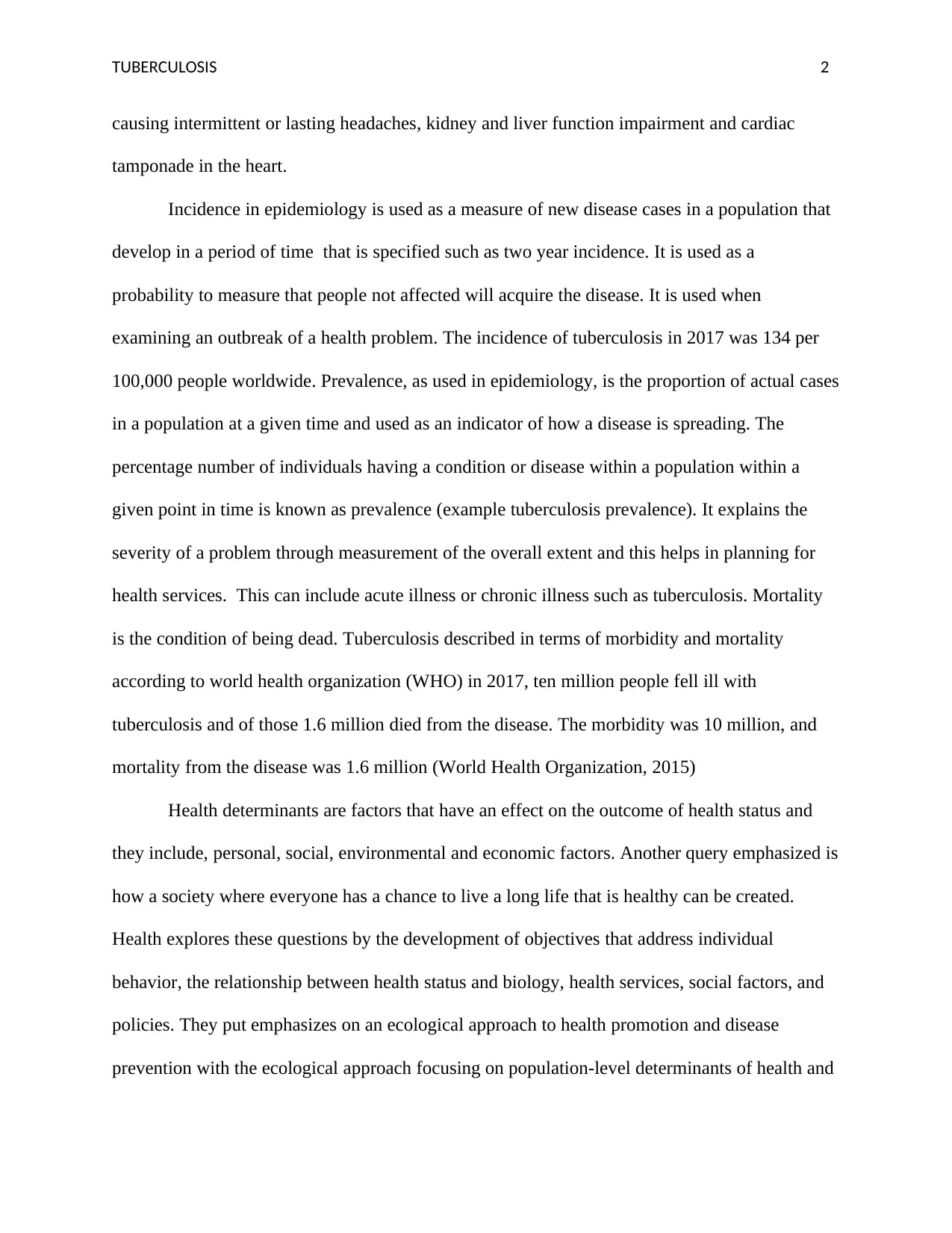
TUBERCULOSIS 2
causing intermittent or lasting headaches, kidney and liver function impairment and cardiac
tamponade in the heart.
Incidence in epidemiology is used as a measure of new disease cases in a population that
develop in a period of time that is specified such as two year incidence. It is used as a
probability to measure that people not affected will acquire the disease. It is used when
examining an outbreak of a health problem. The incidence of tuberculosis in 2017 was 134 per
100,000 people worldwide. Prevalence, as used in epidemiology, is the proportion of actual cases
in a population at a given time and used as an indicator of how a disease is spreading. The
percentage number of individuals having a condition or disease within a population within a
given point in time is known as prevalence (example tuberculosis prevalence). It explains the
severity of a problem through measurement of the overall extent and this helps in planning for
health services. This can include acute illness or chronic illness such as tuberculosis. Mortality
is the condition of being dead. Tuberculosis described in terms of morbidity and mortality
according to world health organization (WHO) in 2017, ten million people fell ill with
tuberculosis and of those 1.6 million died from the disease. The morbidity was 10 million, and
mortality from the disease was 1.6 million (World Health Organization, 2015)
Health determinants are factors that have an effect on the outcome of health status and
they include, personal, social, environmental and economic factors. Another query emphasized is
how a society where everyone has a chance to live a long life that is healthy can be created.
Health explores these questions by the development of objectives that address individual
behavior, the relationship between health status and biology, health services, social factors, and
policies. They put emphasizes on an ecological approach to health promotion and disease
prevention with the ecological approach focusing on population-level determinants of health and
causing intermittent or lasting headaches, kidney and liver function impairment and cardiac
tamponade in the heart.
Incidence in epidemiology is used as a measure of new disease cases in a population that
develop in a period of time that is specified such as two year incidence. It is used as a
probability to measure that people not affected will acquire the disease. It is used when
examining an outbreak of a health problem. The incidence of tuberculosis in 2017 was 134 per
100,000 people worldwide. Prevalence, as used in epidemiology, is the proportion of actual cases
in a population at a given time and used as an indicator of how a disease is spreading. The
percentage number of individuals having a condition or disease within a population within a
given point in time is known as prevalence (example tuberculosis prevalence). It explains the
severity of a problem through measurement of the overall extent and this helps in planning for
health services. This can include acute illness or chronic illness such as tuberculosis. Mortality
is the condition of being dead. Tuberculosis described in terms of morbidity and mortality
according to world health organization (WHO) in 2017, ten million people fell ill with
tuberculosis and of those 1.6 million died from the disease. The morbidity was 10 million, and
mortality from the disease was 1.6 million (World Health Organization, 2015)
Health determinants are factors that have an effect on the outcome of health status and
they include, personal, social, environmental and economic factors. Another query emphasized is
how a society where everyone has a chance to live a long life that is healthy can be created.
Health explores these questions by the development of objectives that address individual
behavior, the relationship between health status and biology, health services, social factors, and
policies. They put emphasizes on an ecological approach to health promotion and disease
prevention with the ecological approach focusing on population-level determinants of health and
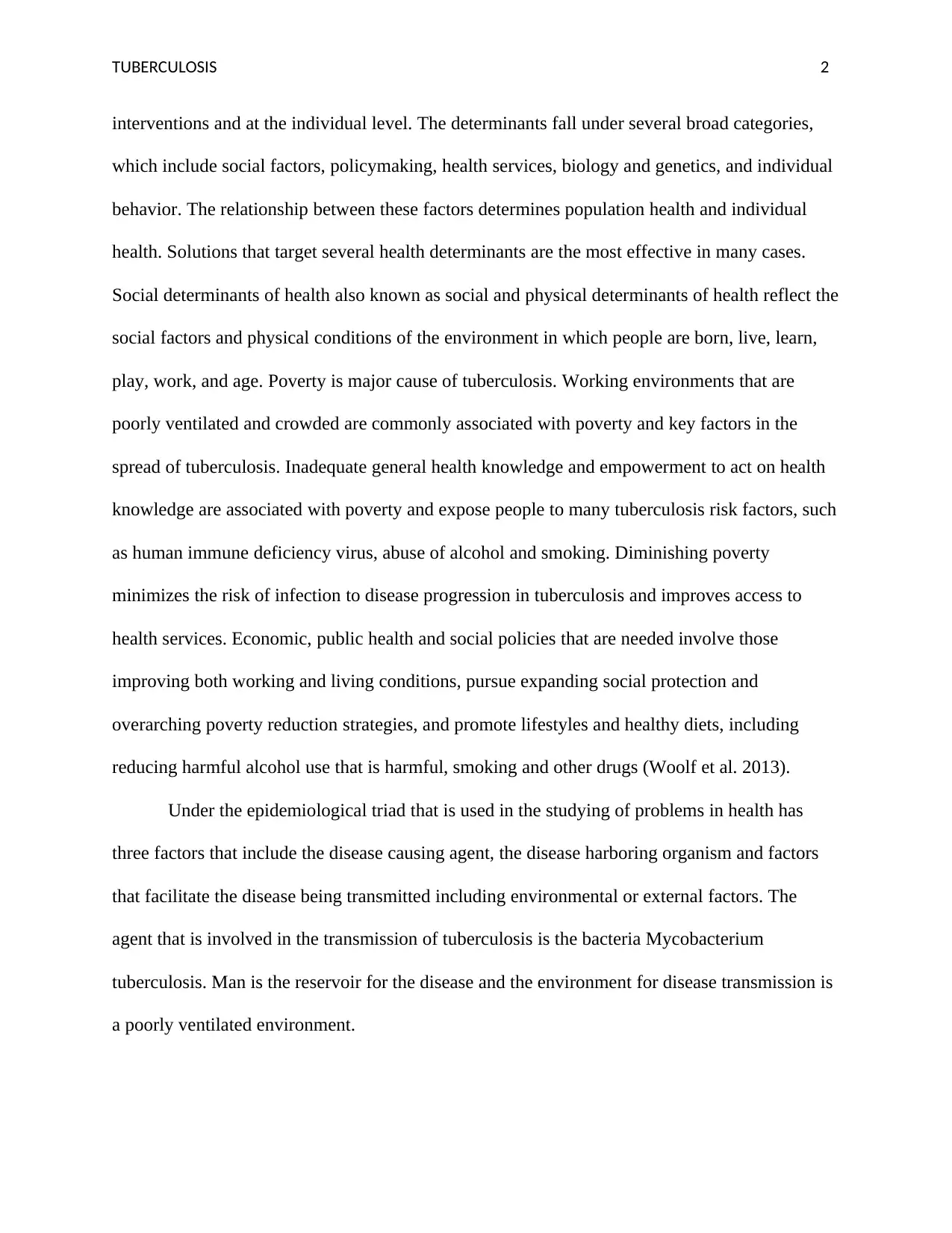
TUBERCULOSIS 2
interventions and at the individual level. The determinants fall under several broad categories,
which include social factors, policymaking, health services, biology and genetics, and individual
behavior. The relationship between these factors determines population health and individual
health. Solutions that target several health determinants are the most effective in many cases.
Social determinants of health also known as social and physical determinants of health reflect the
social factors and physical conditions of the environment in which people are born, live, learn,
play, work, and age. Poverty is major cause of tuberculosis. Working environments that are
poorly ventilated and crowded are commonly associated with poverty and key factors in the
spread of tuberculosis. Inadequate general health knowledge and empowerment to act on health
knowledge are associated with poverty and expose people to many tuberculosis risk factors, such
as human immune deficiency virus, abuse of alcohol and smoking. Diminishing poverty
minimizes the risk of infection to disease progression in tuberculosis and improves access to
health services. Economic, public health and social policies that are needed involve those
improving both working and living conditions, pursue expanding social protection and
overarching poverty reduction strategies, and promote lifestyles and healthy diets, including
reducing harmful alcohol use that is harmful, smoking and other drugs (Woolf et al. 2013).
Under the epidemiological triad that is used in the studying of problems in health has
three factors that include the disease causing agent, the disease harboring organism and factors
that facilitate the disease being transmitted including environmental or external factors. The
agent that is involved in the transmission of tuberculosis is the bacteria Mycobacterium
tuberculosis. Man is the reservoir for the disease and the environment for disease transmission is
a poorly ventilated environment.
interventions and at the individual level. The determinants fall under several broad categories,
which include social factors, policymaking, health services, biology and genetics, and individual
behavior. The relationship between these factors determines population health and individual
health. Solutions that target several health determinants are the most effective in many cases.
Social determinants of health also known as social and physical determinants of health reflect the
social factors and physical conditions of the environment in which people are born, live, learn,
play, work, and age. Poverty is major cause of tuberculosis. Working environments that are
poorly ventilated and crowded are commonly associated with poverty and key factors in the
spread of tuberculosis. Inadequate general health knowledge and empowerment to act on health
knowledge are associated with poverty and expose people to many tuberculosis risk factors, such
as human immune deficiency virus, abuse of alcohol and smoking. Diminishing poverty
minimizes the risk of infection to disease progression in tuberculosis and improves access to
health services. Economic, public health and social policies that are needed involve those
improving both working and living conditions, pursue expanding social protection and
overarching poverty reduction strategies, and promote lifestyles and healthy diets, including
reducing harmful alcohol use that is harmful, smoking and other drugs (Woolf et al. 2013).
Under the epidemiological triad that is used in the studying of problems in health has
three factors that include the disease causing agent, the disease harboring organism and factors
that facilitate the disease being transmitted including environmental or external factors. The
agent that is involved in the transmission of tuberculosis is the bacteria Mycobacterium
tuberculosis. Man is the reservoir for the disease and the environment for disease transmission is
a poorly ventilated environment.
⊘ This is a preview!⊘
Do you want full access?
Subscribe today to unlock all pages.

Trusted by 1+ million students worldwide
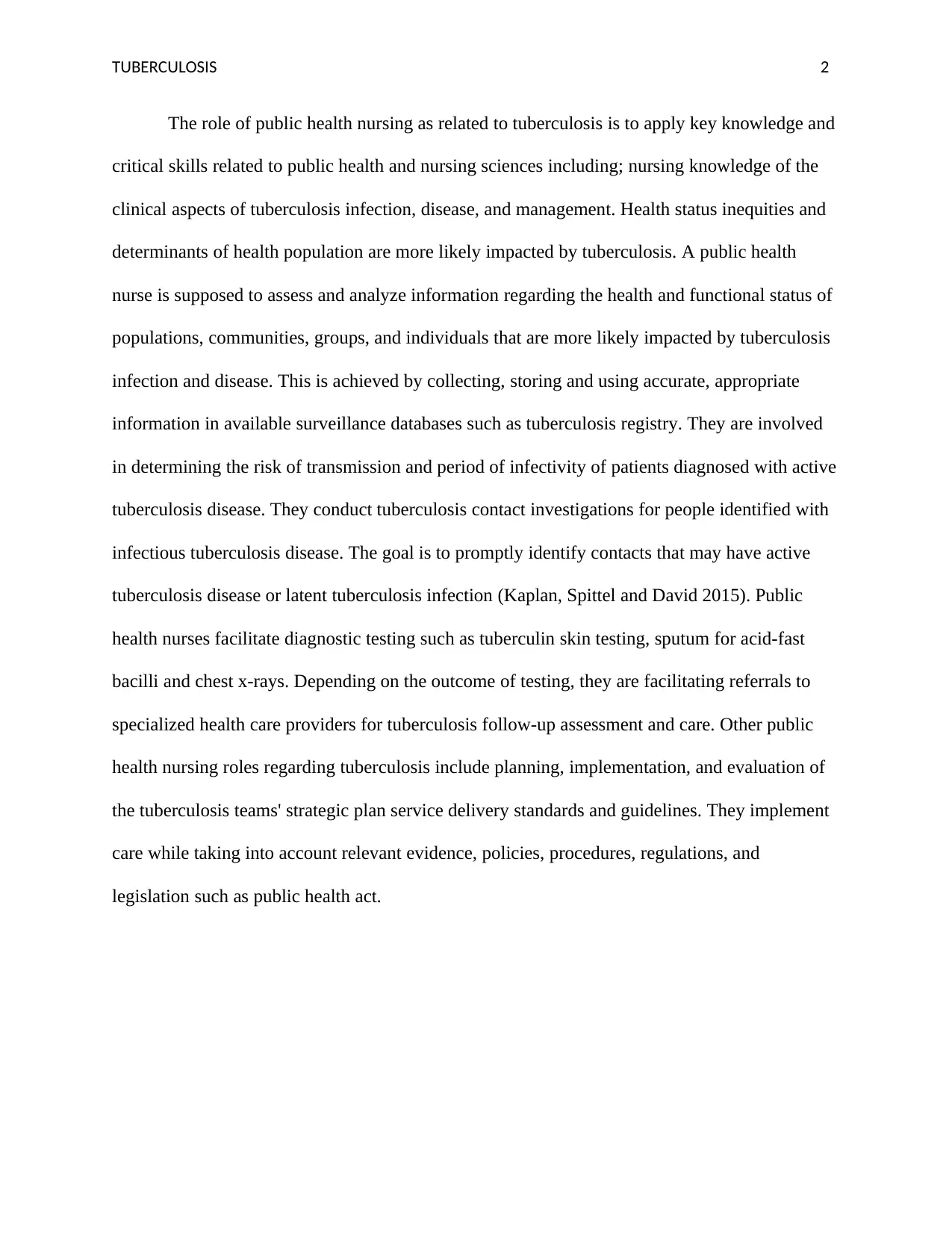
TUBERCULOSIS 2
The role of public health nursing as related to tuberculosis is to apply key knowledge and
critical skills related to public health and nursing sciences including; nursing knowledge of the
clinical aspects of tuberculosis infection, disease, and management. Health status inequities and
determinants of health population are more likely impacted by tuberculosis. A public health
nurse is supposed to assess and analyze information regarding the health and functional status of
populations, communities, groups, and individuals that are more likely impacted by tuberculosis
infection and disease. This is achieved by collecting, storing and using accurate, appropriate
information in available surveillance databases such as tuberculosis registry. They are involved
in determining the risk of transmission and period of infectivity of patients diagnosed with active
tuberculosis disease. They conduct tuberculosis contact investigations for people identified with
infectious tuberculosis disease. The goal is to promptly identify contacts that may have active
tuberculosis disease or latent tuberculosis infection (Kaplan, Spittel and David 2015). Public
health nurses facilitate diagnostic testing such as tuberculin skin testing, sputum for acid-fast
bacilli and chest x-rays. Depending on the outcome of testing, they are facilitating referrals to
specialized health care providers for tuberculosis follow-up assessment and care. Other public
health nursing roles regarding tuberculosis include planning, implementation, and evaluation of
the tuberculosis teams' strategic plan service delivery standards and guidelines. They implement
care while taking into account relevant evidence, policies, procedures, regulations, and
legislation such as public health act.
The role of public health nursing as related to tuberculosis is to apply key knowledge and
critical skills related to public health and nursing sciences including; nursing knowledge of the
clinical aspects of tuberculosis infection, disease, and management. Health status inequities and
determinants of health population are more likely impacted by tuberculosis. A public health
nurse is supposed to assess and analyze information regarding the health and functional status of
populations, communities, groups, and individuals that are more likely impacted by tuberculosis
infection and disease. This is achieved by collecting, storing and using accurate, appropriate
information in available surveillance databases such as tuberculosis registry. They are involved
in determining the risk of transmission and period of infectivity of patients diagnosed with active
tuberculosis disease. They conduct tuberculosis contact investigations for people identified with
infectious tuberculosis disease. The goal is to promptly identify contacts that may have active
tuberculosis disease or latent tuberculosis infection (Kaplan, Spittel and David 2015). Public
health nurses facilitate diagnostic testing such as tuberculin skin testing, sputum for acid-fast
bacilli and chest x-rays. Depending on the outcome of testing, they are facilitating referrals to
specialized health care providers for tuberculosis follow-up assessment and care. Other public
health nursing roles regarding tuberculosis include planning, implementation, and evaluation of
the tuberculosis teams' strategic plan service delivery standards and guidelines. They implement
care while taking into account relevant evidence, policies, procedures, regulations, and
legislation such as public health act.
Paraphrase This Document
Need a fresh take? Get an instant paraphrase of this document with our AI Paraphraser
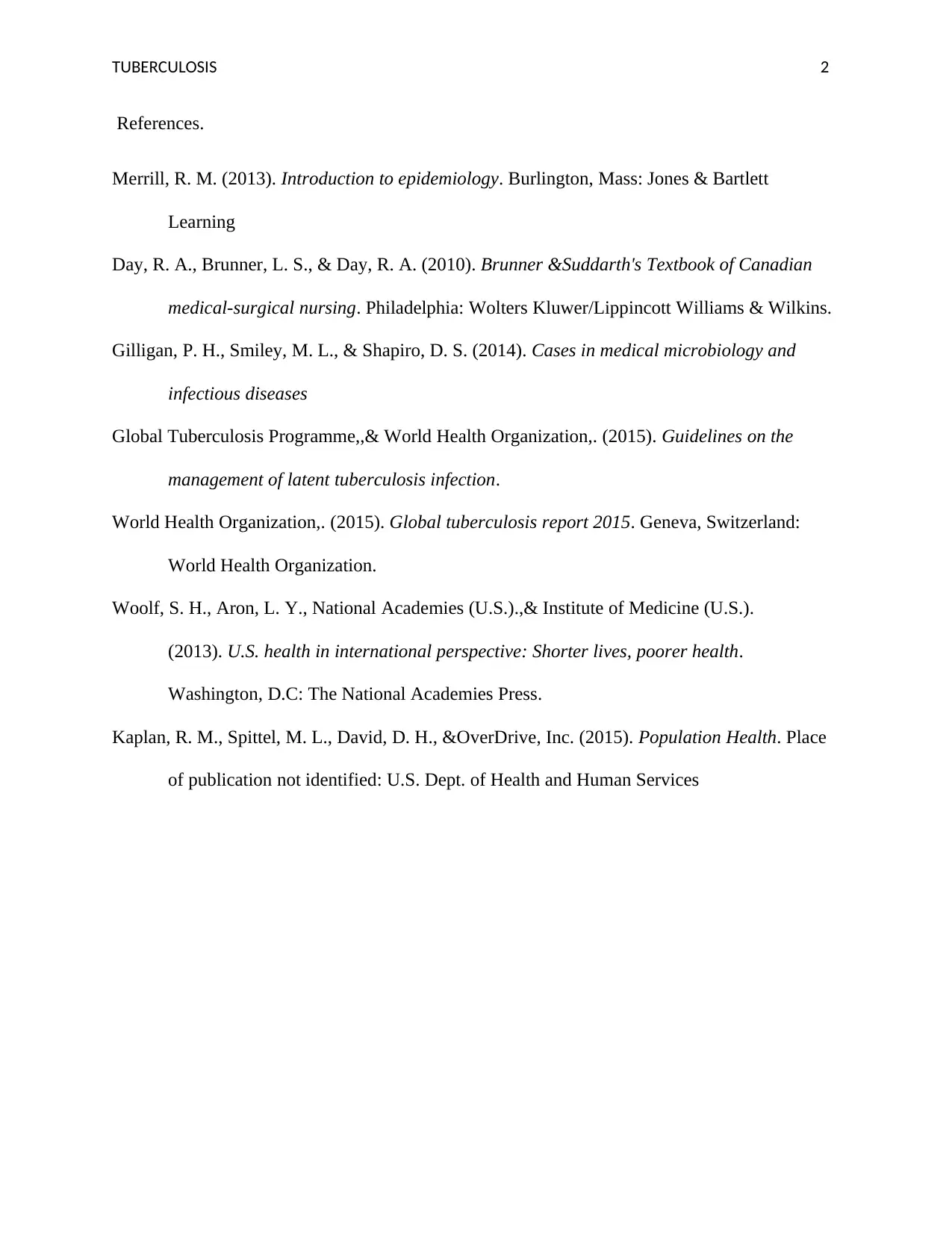
TUBERCULOSIS 2
References.
Merrill, R. M. (2013). Introduction to epidemiology. Burlington, Mass: Jones & Bartlett
Learning
Day, R. A., Brunner, L. S., & Day, R. A. (2010). Brunner &Suddarth's Textbook of Canadian
medical-surgical nursing. Philadelphia: Wolters Kluwer/Lippincott Williams & Wilkins.
Gilligan, P. H., Smiley, M. L., & Shapiro, D. S. (2014). Cases in medical microbiology and
infectious diseases
Global Tuberculosis Programme,,& World Health Organization,. (2015). Guidelines on the
management of latent tuberculosis infection.
World Health Organization,. (2015). Global tuberculosis report 2015. Geneva, Switzerland:
World Health Organization.
Woolf, S. H., Aron, L. Y., National Academies (U.S.).,& Institute of Medicine (U.S.).
(2013). U.S. health in international perspective: Shorter lives, poorer health.
Washington, D.C: The National Academies Press.
Kaplan, R. M., Spittel, M. L., David, D. H., &OverDrive, Inc. (2015). Population Health. Place
of publication not identified: U.S. Dept. of Health and Human Services
References.
Merrill, R. M. (2013). Introduction to epidemiology. Burlington, Mass: Jones & Bartlett
Learning
Day, R. A., Brunner, L. S., & Day, R. A. (2010). Brunner &Suddarth's Textbook of Canadian
medical-surgical nursing. Philadelphia: Wolters Kluwer/Lippincott Williams & Wilkins.
Gilligan, P. H., Smiley, M. L., & Shapiro, D. S. (2014). Cases in medical microbiology and
infectious diseases
Global Tuberculosis Programme,,& World Health Organization,. (2015). Guidelines on the
management of latent tuberculosis infection.
World Health Organization,. (2015). Global tuberculosis report 2015. Geneva, Switzerland:
World Health Organization.
Woolf, S. H., Aron, L. Y., National Academies (U.S.).,& Institute of Medicine (U.S.).
(2013). U.S. health in international perspective: Shorter lives, poorer health.
Washington, D.C: The National Academies Press.
Kaplan, R. M., Spittel, M. L., David, D. H., &OverDrive, Inc. (2015). Population Health. Place
of publication not identified: U.S. Dept. of Health and Human Services
1 out of 8
Related Documents
Your All-in-One AI-Powered Toolkit for Academic Success.
+13062052269
info@desklib.com
Available 24*7 on WhatsApp / Email
![[object Object]](/_next/static/media/star-bottom.7253800d.svg)
Unlock your academic potential
Copyright © 2020–2025 A2Z Services. All Rights Reserved. Developed and managed by ZUCOL.





